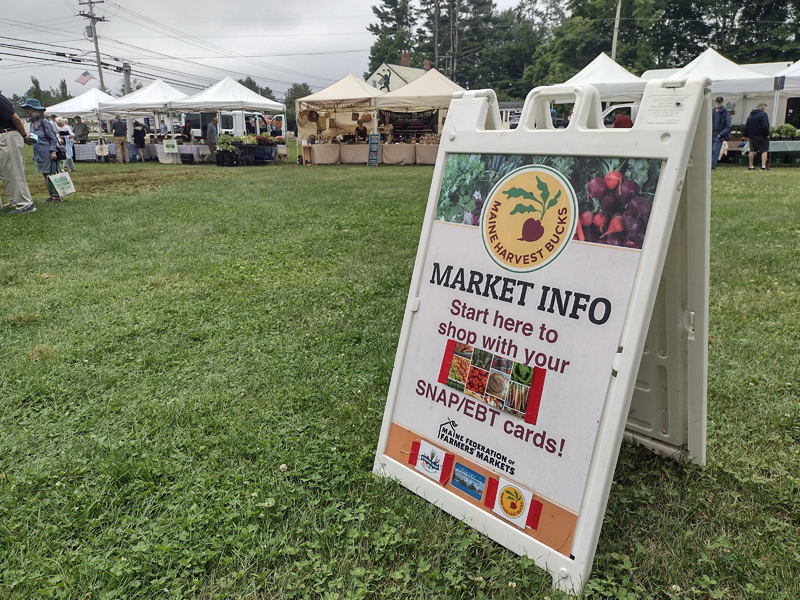
The information booth sign for Damariscotta Farmers Market, where the vendors have a long history of supporting shopping with SNAP at the market. (Photo courtesy Healthy Lincoln County)
With so many potential funding changes in the news and on our minds, it seems like a good time to revisit one of America’s most crucial programs, the Supplemental Nutrition Assistance Program, known as SNAP.
SNAP is a federally funded program administered in Maine through the Office of Family Independence. Formerly known as “food stamps,” it is a program that helps households pay for food. SNAP benefits can help ease the burden of households having to make tough choices between food, housing, medical bills, and other expenses. Though with current expenses, many folks utilizing SNAP also need to access other services, like pantries, to meet just the basic needs.
SNAP aims to allow families to transition to self-sufficiency and financial stability. It is tied to better health outcomes than people who are lower-income and not receiving SNAP benefits, reduces childhood food insecurity, and can be a crucial safety net when people hit a hard time.
As of January, 3,602 individuals were enrolled in SNAP in Lincoln County. And since Maine has the highest rate of childhood food insecurity in New England, many of our community’s children rely on SNAP – as well as school meal programs – to ensure they get to eat each day.
According to the Center on Budget and Policy Priorities, in 2024, over 50% of Maine’s SNAP participants were families with children. More than 53% were families with members who are older adults or adults with disabilities. Almost 40% were working families.
SNAP is a program that many families rely on to get through a hard time, and a benefit that many older adults depend on to contribute to their fixed budgets. Since pandemic supports ended, families have already seen drastic changes to their benefits and often lose benefits completely if they get a new job or their income changes, even if they are not yet financially secure.
Along with supporting individuals and families, SNAP stimulates local economies and supports increased spending within the community. Nationally, about 80% of SNAP-approved retailers are small businesses, including small grocers, convenience stores, and general stores.
Many farmers markets and farmstands also accept SNAP as payment, and frequently have an incentive program attached to help stretch SNAP dollars, get more local foods into people’s kitchens, and increase spending directly with farmers.
It is clear that this food assistance program is vital to the individuals, families, and businesses of Lincoln County. Many of us have accessed this benefit at one point or another, as financial hardship can impact anyone.
Here at Healthy Lincoln County, we are especially appreciative of SNAP, since some of our projects are directly connected to the program.
Think you might qualify for SNAP but aren’t sure? Eligibility is based on income, assets, expenses, and household size. For more details on the application process and to check out a screening tool, visit this SNAP resource page through Midcoast Hunger Prevention Program at mchpp.org/snap.



